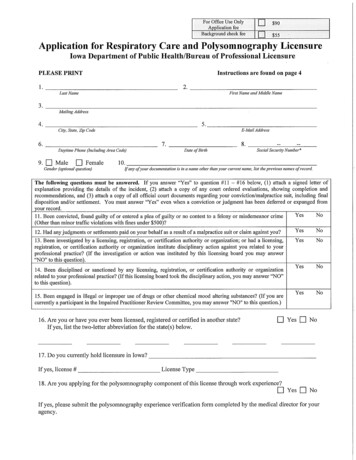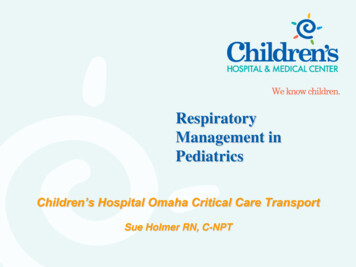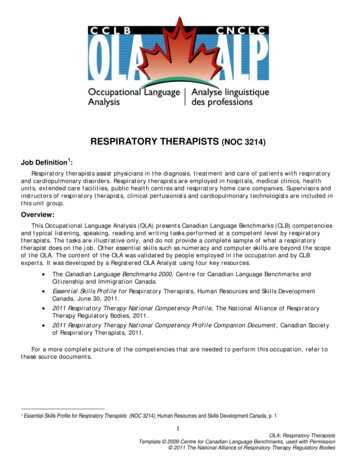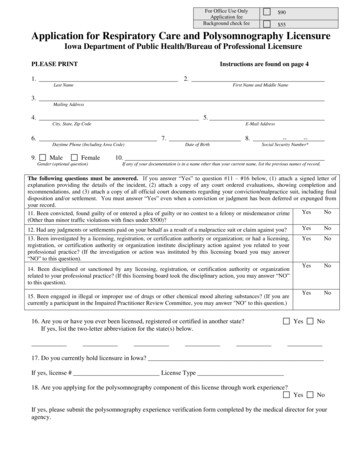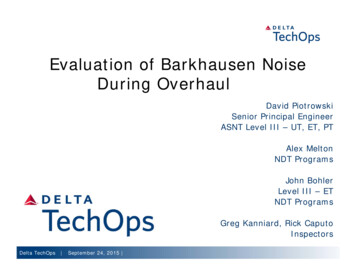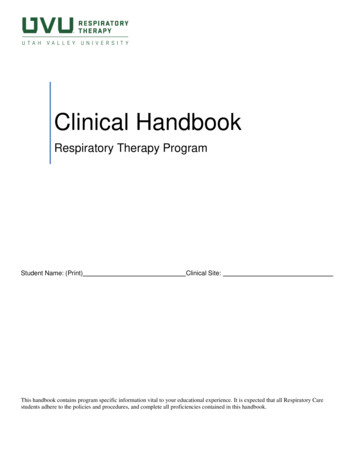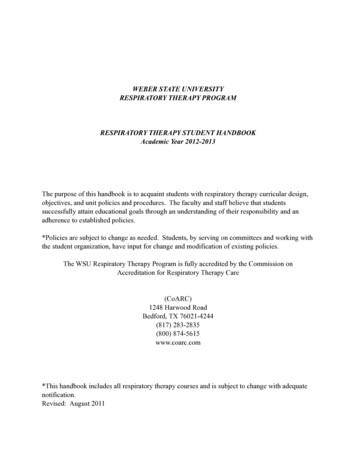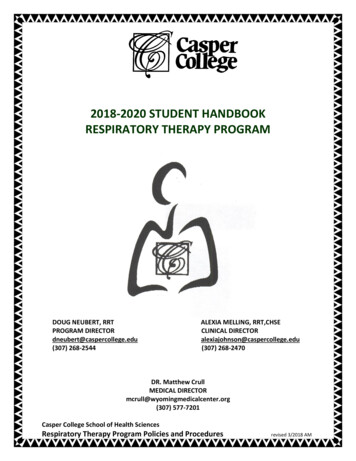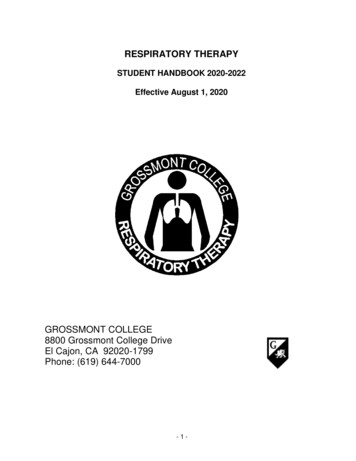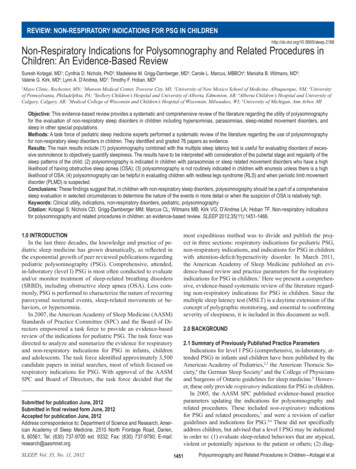
Transcription
REVIEW: NON-RESPIRATORY INDICATIONS FOR PSG IN spiratory Indications for Polysomnography and Related Procedures inChildren: An Evidence-Based ReviewSuresh Kotagal, MD1; Cynthia D. Nichols, PhD2; Madeleine M. Grigg-Damberger, MD3; Carole L. Marcus, MBBCh4; Manisha B. Witmans, MD5;Valerie G. Kirk, MD6; Lynn A. D’Andrea, MD7; Timothy F. Hoban, MD81Mayo Clinic, Rochester, MN; 2Munson Medical Center, Traverse City, MI; 3University of New Mexico School of Medicine, Albuquerque, NM; 4Universityof Pennsylvania, Philadelphia, PA; 5Stollery Children’s Hospital and University of Alberta, Edmonton, AB; 6Alberta Children’s Hospital and University ofCalgary, Calgary, AB; 7Medical College of Wisconsin and Children’s Hospital of Wisconsin, Milwaukee, WI; 8University of Michigan, Ann Arbor, MIObjective: This evidence-based review provides a systematic and comprehensive review of the literature regarding the utility of polysomnographyfor the evaluation of non-respiratory sleep disorders in children including hypersomnias, parasomnias, sleep-related movement disorders, andsleep in other special populations.Methods: A task force of pediatric sleep medicine experts performed a systematic review of the literature regarding the use of polysomnographyfor non-respiratory sleep disorders in children. They identified and graded 76 papers as evidence.Results: The main results include (1) polysomnography combined with the multiple sleep latency test is useful for evaluating disorders of excessive somnolence to objectively quantify sleepiness. The results have to be interpreted with consideration of the pubertal stage and regularity of thesleep patterns of the child; (2) polysomnography is indicated in children with parasomnias or sleep related movement disorders who have a highlikelihood of having obstructive sleep apnea (OSA); (3) polysomnography is not routinely indicated in children with enuresis unless there is a highlikelihood of OSA; (4) polysomnography can be helpful in evaluating children with restless legs syndrome (RLS) and when periodic limb movementdisorder (PLMD) is suspected.Conclusions: These findings suggest that, in children with non-respiratory sleep disorders, polysomnography should be a part of a comprehensivesleep evaluation in selected circumstances to determine the nature of the events in more detail or when the suspicion of OSA is relatively high.Keywords: Clinical utility, indications, non-respiratory disorders, pediatric, polysomnographyCitation: Kotagal S; Nichols CD; Grigg-Damberger MM; Marcus CL; Witmans MB; Kirk VG; D’Andrea LA; Hoban TF. Non-respiratory indicationsfor polysomnography and related procedures in children: an evidence-based review. SLEEP 2012;35(11):1451-1466.1.0 INTRODUCTIONIn the last three decades, the knowledge and practice of pediatric sleep medicine has grown dramatically, as reflected inthe exponential growth of peer reviewed publications regardingpediatric polysomnography (PSG). Comprehensive, attended,in-laboratory (level I) PSG is most often conducted to evaluateand/or monitor treatment of sleep-related breathing disorders(SRBD), including obstructive sleep apnea (OSA). Less commonly, PSG is performed to characterize the nature of recurringparoxysmal nocturnal events, sleep-related movements or behaviors, or hypersomnia.In 2007, the American Academy of Sleep Medicine (AASM)Standards of Practice Committee (SPC) and the Board of Directors empowered a task force to provide an evidence-basedreview of the indications for pediatric PSG. The task force wasdirected to analyze and summarize the evidence for respiratoryand non-respiratory indications for PSG in infants, childrenand adolescents. The task force identified approximately 3,500candidate papers in initial searches, most of which focused onrespiratory indications for PSG. With approval of the AASMSPC and Board of Directors, the task force decided that themost expeditious method was to divide and publish the project in three sections: respiratory indications for pediatric PSG,non-respiratory indications, and indications for PSG in childrenwith attention-deficit/hyperactivity disorder. In March 2011,the American Academy of Sleep Medicine published an evidence-based review and practice parameters for the respiratoryindications for PSG in children.1 Here we present a comprehensive, evidence-based systematic review of the literature regarding non-respiratory indications for PSG in children. Since themultiple sleep latency test (MSLT) is a daytime extension of theconcept of polygraphic monitoring, and essential to confirmingseverity of sleepiness, it is included in this document as well.2.0 BACKGROUND2.1 Summary of Previously Published Practice ParametersIndications for level I PSG (comprehensive, in-laboratory, attended PSG) in infants and children have been published by theAmerican Academy of Pediatrics,2,3 the American Thoracic Society,4 the German Sleep Society5 and the College of Physiciansand Surgeons of Ontario guidelines for sleep medicine.6 However, these only provide respiratory indications for PSG in children.In 2005, the AASM SPC published evidence-based practiceparameters updating the indications for polysomnography andrelated procedures. These included non-respiratory indicationsfor PSG and related procedures,7 and were a revision of earlierguidelines and indications for PSG.8,9 These did not specificallyaddress children, but advised that a level I PSG may be indicatedin order to: (1) evaluate sleep-related behaviors that are atypical,violent or potentially injurious to the patient or others; (2) diag-Submitted for publication June, 2012Submitted in final revised form June, 2012Accepted for publication June, 2012Address correspondence to: Department of Science and Research, American Academy of Sleep Medicine, 2510 North Frontage Road, Darien,IL 60561; Tel: (630) 737-9700 ext. 9332; Fax: (630) 737-9790; E-mail:research@aasmnet.orgSLEEP, Vol. 35, No. 11, 20121451Polysomnography and Related Procedures in Children—Kotagal et al
important areas where there is insufficient evidence for the clinical utility of PSG; and (5) identify strengths and limitations ofthe current medical literature regarding this subject.Table 1—Literature Search CriteriaInclusion CriteriaGreater than or equal to 10 subjectsSubjects must be less than or equal to 18 years of age(at least 1 month, no newborns)3.0 METHODSThe task force and SPC liaisons made a list of questions or issues regarding non-respiratory indications for PSG in children.From this, Population, Intervention, Comparison, and Outcome(PICO) tables were developed which guided the review process to be focused on clinically relevant issues. PICO tables forthis project are available on the AASM website (http://www.aasmnet.org/practiceguidelines.aspx). We then: (1) reviewedprevious AASM publications and papers produced by otherorganizations for PSG indications; (2) developed a literaturesearch strategy; (3) established criteria for selecting relevantpapers; (4) developed procedures for extracting data and grading the strength of evidence of selected papers; and (5) collatedand summarized the evidence. The task force, SPC liaisons, andAASM support staff held monthly telephone conference callsand yearly face-to-face meetings.Must have PSG data (not home PSG) including EEG, EMG,and respiratory parametersLimitsEnglish languageHuman subjectsPublication Date Range1966 through September 2010nose certain other atypical or unusual parasomnias; (3) evaluatenarcolepsy or idiopathic hypersomnia, along with a MSLT; (4) determine nocturnal seizures when clinical evaluation and daytimeelectroencephalography (EEG) remain inconclusive; (5) clarifywhether paroxysmal arousals or other sleep disruptions are dueto an epileptic or non-epileptic parasomnias, and/or (6) confirm astrong suspicion of periodic limb movement disorder (PLMD).7The 2005 AASM guidelines further emphasize that a PSG isnot the best primary test to evaluate patients with insomnia orcircadian rhythm disorders. An earlier AASM SPC guidelinespecified that a PSG may be indicated in patients with insomniawhen: (1) a SRBD or PLMD is suspected; (2) the initial diagnosis is uncertain; or (3) violent or potentially injurious precipitous arousals occur.9-12In 2005, the AASM published an evidence-based review13and practice parameters for the clinical use of the MSLT andthe maintenance of wakefulness test (MWT) in adults.14 Theserecommended that: (1) the MSLT is indicated as part of theevaluation of patients suspected to have narcolepsy or idiopathic hypersomnia; and (2) a MWT may be indicated in the assessment of individuals in whom the inability to remain awakeconstitutes a safety issue or in patients with narcolepsy withcataplexy/idiopathic hypersomnia to assess the effects of alertness-enhancing treatments.3.1 Literature Search StrategyThe project was divided into sections in order to systematicallyanalyze the medical literature for the indications for and clinicalutility of comprehensive attended level I PSG in: (1) narcolepsyand other hypersomnias; (2) parasomnias; (3) sleep-related movements disorders (SRMD); and 4) sleep in special populations.Searches were also performed for evidence on the use of MSLTand MWT in children. Technical guidelines for PSG are not addressed because these have been addressed in the AASM ScoringManual.15 Also not reviewed is the use of nap studies or homePSG because of limited evidence for these in children.Search terms and search strategies with which to query themedical literature for the indications for and clinical utilityof comprehensive, attended level I PSG in pediatric patientswere developed. Table 1 summarizes the explicit inclusion criteria, publication date range, and other search limitations thatwere used. A complete list of search terms for each categoryis provided on the AASM website (http://www.aasmnet.org/practiceguidelines.aspx). Using PubMed for the literature search,a master list of potential evidence papers was assembled. Twotask force members were assigned to review the candidate abstracts and identify those papers that definitively met the criteriafor inclusion. If the two members disagreed regarding inclusion/exclusion of a particular paper, additional ratings were obtainedby other task force members. The task force chair provided thefinal opinion in cases of disagreement. Accepted articles wereassigned to the appropriate section(s) of the review paper.A second method of finding candidate papers called “pearling” was also used. Pearling identifies additional papers suitable for evidence by searching the citations of papers alreadyincluded as evidence or alternatively, utilizing a task forcemember’s personal knowledge of literature in the field. Pearledarticles underwent the same review process. The results of theliterature search are discussed in Section 4.0.2.2 Composition of the Task ForceThe task force was composed of specialists with establishedclinical expertise and experience in pediatric sleep medicine.All completed AASM conflict of interest forms confirmingnone had relevant conflicts of interest or commercial bias. Mosthad authored the 2011 Respiratory Indications for Polysomnography in Children paper, with the exception of Dr. Kotagal whoreplaced Dr. Wise as task force chair when Dr. Wise became amember of the AASM Board of Directors in 2010.2.3 ObjectivesThe objectives of the task force were to: (1) provide a systematic and comprehensive review of the relevant medical literature regarding non-respiratory indications for PSG in children;(2) grade the strength of the evidence contained in the literatureusing a standardized grading system; (3) summarize the information regarding the validity, reliability, and clinical utility ofPSG for non-respiratory sleep disorders in children; (4) addressSLEEP, Vol. 35, No. 11, 20123.2 Data Extraction and Evidence Grading ProcessThe data extraction and evidence grading process was similarto that used in Respiratory Indications for Polysomnography in1452Polysomnography and Related Procedures in Children—Kotagal et al
Children,16 except an Excel spreadsheet was used to summarizeand manage the data extraction and evidence grading. The completed evidence table is available at he evidence grading system (Table 2) was modified fromone developed by the American Academy of Neurology (AAN)specifically for assessing the clinical utility of diagnostic tests.17The system designates four levels of evidence: studies judgedlevel 1 have stronger scientific evidence and a lower risk ofbias, while level 4 have weaker scientific evidence and a higherrisk of bias. Weaker levels of evidence indicate the need to integrate greater clinical judgment when applying the results toclinical decision making.Table 2—Levels of Evidence174.0 RESULTSOur initial literature search identified 3,500 candidate papersfor respiratory and non-respiratory indications for PSG. We laterdivided the project into 3 parts: (1) Respiratory Indications, whichwere published March 2011, (2) the current paper on Non-Respiratory Indications for PSG, and (3) indications for PSG in children with attention-deficit/hyperactivity disorder. We performedtwo additional literature searches in 2009 and 2010, specificallyfor non-respiratory indications, and identified another 887 papers.Specialized searches and pearling were also employed to ensurethe inclusion of any extra articles that may have been missed.Approximately 4,450 total candidate papers were identified andscreened using the inclusion criteria, and 76 were selected as evidence.The evidence in each article was graded by a primary andsecondary reviewer of the task force, with grades obtainedfrom additional reviewers if the two disagreed. Grading by theprimary and secondary reviewers were in excellent agreement(gamma 0.94, P 0.05) overall. For the papers on whichthere was disagreement, the secondary reviewer was in betteragreement with the additional reviewers (gamma ranged from0.92-1.0 with P 0.05 for all additional comparisons to the secondary rating, but gamma ranged from 0.39-1.0 for the additional comparisons to the grade of the primary reviewer).The interpretation of sleep research in children with nonrespiratory sleep disorders was challenging, at times, due to thesignificant procedural variability between studies. Methodological concerns identified included: (1) variability in diagnostic,recording, and scoring methods, (2) presence of identified orunidentified comorbid conditions that potentially account forthe PSG findings, (3) variability in the age range and pubertal status of the subjects, (4) normative values and selection ofappropriate control groups, and (5) potential risk of both type1 and type 2 error when multiple measures are obtained andanalyzed on small samples of subjects. These concerns wereidentified and cited in the evidence tables.The results are presented in four sections: hypersomnias,parasomnias, sleep related movement disorders (SRMD), andsleep in special populations.Description1Evidence provided by a prospective study in a broadspectrum of persons with the suspected condition, usinga reference (gold) standard for case definition, wheretest is applied in a blinded fashion, and enabling theassessment of appropriate test of diagnostic accuracy. Allpersons undergoing the diagnostic test have the presenceor absence of the disease determined. Level 1 studies arejudged to have a low risk of bias.2Evidence provided by a prospective study of a narrowspectrum of persons with the suspected condition, or awell designed retrospective study of a broad spectrumof persons with an established condition (by “goldstandard”) compared to a broad spectrum of controls,where test is applied in a blinded evaluation, and enablingthe assessment of appropriate tests of diagnostic accuracy.Level 2 studies are judged to have a moderate risk of bias.3Evidence provided by a retrospective study where eitherperson with the established condition or controls are of anarrow spectrum, and where the reference standard,if not objective, is applied by someone other than theperson that performed (interpreted) the test. Level 3studies are judged to have a moderate to high risk of bias.4Any study design where test is not applied in anindependent evaluation or evidence is provided byexpert opinion alone or in descriptive case serieswithout controls. There is no blinding or there may beinadequate blinding. The spectrum of persons testedmay be broad or narrow. Level 4 studies are judged tohave a very high risk of bias.MSLT were in children,18 the test is mostly used to evaluateadults. Our search identified 22 articles regarding the use of theMSLT in children and adolescents. The aims of these paperswere to describe normative sleep patterns in children and adolescents or evaluate sleepiness in relation to particular diseasestates; none were designed to specifically evaluate the clinicalutility of the MSLT. Two papers provided level 1 evidence,19,20seven level 3,21-27 and thirteen level 4 evidence.18,28-39 With theexception of a level 3 paper that included 3-year-olds,22 all studies were restricted to children 5 years of age (an age whenchildren typically stop taking daytime naps). All showed thefeasibility of performing MSLTs in developmentally normalschool-aged children.4.1.1 Normative MSLT values in children and adolescentsSeveral studies provided normative data based on children ofdifferent ages/Tanner stages, but most were level 3 or 4 and hadsmall sample sizes. Our search identified six studies, including two with level 3 evidence,21,22 and four level 4.18,29,34,37 Allshowed that developmentally normal, prepubertal, school-agedchildren rarely fall asleep during standard 20-minute daytimenap opportunities,18,29,34,37 and that older (Tanner stages 3-5) adolescents are sleepier on MSLT.18,21,34 Because of this so-calledceiling effect (mean sleep latencies of 16 to 18 minutes), somestudies lengthened the nap opportunities to 30 minutes.22,37Some, but not all, studies show older adolescents may exhibit a midday increase in sleepiness which could impact the decision of whether to perform 4 or 5 naps during an MSLT. One4.1 Clinical Utility of PSG in Children with Daytime Sleepiness(Including Narcolepsy), Idiopathic Hypersomnia, Hypersomniadue to Medical Conditions, and Other HypersomniasThe MSLT is used to characterize and objectively measuredaytime sleepiness. Although some of the earliest uses of theSLEEP, Vol. 35, No. 11, 2012Level1453Polysomnography and Related Procedures in Children—Kotagal et al
level 4 study showed a midday increase in daytime sleepinessin Tanner stage 3 and 4 adolescents on a constant routine protocol (but not at baseline); an effect not seen in Tanner 1 and 2children.29 A second level 4 paper by this group found the sameeffect in children of Tanner stages 3-5.18 Another level 4 studyshowed decreased sleep latency at 14:00 in adolescents aged13-17 years.34 A level 4 study mentioned a nonsignificant trendfor decreased sleep latency at 12:00 in children ages 8-12 yearsold.37 A level 3 study mentioned that children were more likelyto fall asleep at 14:00 but did not provide statistical details.22Based on these studies, the preponderance of evidence suggests that older adolescents may have increased sleepinessmid-day, but further data are needed, particularly regarding theimpact of early school start times and sleeping in on weekendson the results of the MSLT. One level 3 study showed that anearly school start time of 07:20 in 10th graders was associatedwith a shorter mean sleep latency (MSL) on the MSLT of 8.5minutes compared to 11.4 minutes in the 9th graders whoseschool start time was 08:25. The sleep latency was particularlyshort for the first nap at 08:30 (5.1 vs. 10.9 minutes).21 Morningwake times may also impact the MSLT findings, but this has notbeen well studied.Very few studies have reported or even commented uponsleep onset REM periods (SOREMPS) during the MSLT innormal controls. One level 4 study reported no SOREMPSin young children,18 whereas a level 3 study of older adolescents found 48% had at least one SOREMP and 16% had 2SOREMPs.21 Our search found no normative data for the MWTin children.None of the reviewed studies had the specific objective ofdetermining the sensitivity and specificity of MSLT for diagnosing narcolepsy. However, some studies performed MSLTsin patients with a clear phenotype of narcolepsy with cataplexy.Our search identified six relevant retrospective studies: onelevel 3 evidence23 and five level 4 evidence.28,30-32,38One level 4 study evaluated 58 patients younger than 21years, all of whom had excessive daytime sleepiness for atleast a year and unequivocal symptoms of narcolepsy. Theyfound that 79% met MSLT criteria for narcolepsy (MSL 8minutes and 2 SOREMPs).30 In another level 4 study of children (mean age 11 years) with excessive daytime sleepiness andcataplexy, 28 of 29 children had a MSL 5 minutes on MSLT,and 28 of 29 had 2 SOREMPs.32 In a small level 4 case seriesof 14 children (10 with cataplexy), 12 had mean sleep latencies 8 minutes on MSLT and 13 had 2 SOREMPs.38 In a level3 study of adolescents recruited from the community by meansof questionnaires, 9 of 20 children with a positive telephonicscreening for narcolepsy symptoms had an MSLT consistentwith narcolepsy (2 were diagnosed as having narcolepsy withcataplexy and 7 narcolepsy without cataplexy).23 This article isless convincing of the diagnostic sensitivity and specificity ofthe MSLT for childhood narcolepsy as subjects did not present clinically, and few had cataplexy, suggesting that the diagnosis of narcolepsy may not have been definitive. Anotherlevel 4 study reported on 44 prepubertal children with clinicallydiagnosed narcolepsy who underwent MSLT.31 In some cases,MSLTs were repeated. The authors noted that all children had aMSL 5 minutes and 2 SOREMPs on initial or repeat testing,suggesting a high sensitivity for MSLT testing. However, it isnot clear from this paper how the diagnosis of narcolepsy wasestablished or how many children had initial negative MSLTsand required repeat testing. A level 4 study of 51 children diagnosed with narcolepsy found that 3 (15%) prepubertal childrenhad a negative MSLT (defined as a MSL 8 minutes and 2SOREMPs); 2 of these children had undetectable cerebrospinalfluid hypocretin 1 levels.28In summary, retrospective surveys have shown that MSLT ishighly sensitive in confirming narcolepsy in children with presumptive narcolepsy based on a history of excessive daytimesleepiness and cataplexy. The sensitivity of MSLTs in diagnosing children with narcolepsy without cataplexy is unclear. Thespecificity of the MSLT in diagnosing narcolepsy could not bedetermined from the published literature.Evidence regarding the use of MSLT to assess the responseto treatment of childhood narcolepsy is scant. One level 1 studyof adolescents with narcolepsy found that treating them witheither modafinil or sodium oxybate was associated with modest improvements in their MSL compared to baseline, althoughtheir MSL remained 6 minutes.20 A level 4 study of childrenwith narcolepsy found mean MSLT scores increased from 6.6 3.7 minutes at baseline to 10.2 4.8 minutes when they weretreated with modafinil.33Although PSG is almost universally performed the nightprior to MSLT to assess sufficient nocturnal sleep durationand screen for other sleep disorders which may contribute toor cause daytime sleepiness, few studies have systematicallyexamined nocturnal PSG measures in children with narcolepsy.Five level 4 studies of narcoleptic children have reported fre-4.1.2 Clinical utility of PSG and MSLT for the assessment ofprimary hypersomnias in childrenAs is the case for adults, PSG and MSLT are frequentlyused in the assessment of narcolepsy and other hypersomniasin children. Our search identified nine articles regarding theuse of PSG/MSLT in childhood narcolepsy and one in KleineLevin syndrome. The lower age limit for clinical applicationof the MSLT was 5-5.5 years.30,39 Among these 10 papers, oneprovided level 1 evidence,20 two level 3,23,24 and seven level4.30-33,36,38,39 These studies were not homogeneous with respectto the age groups studied (range 2.1 to 21 years), and only a fewreported MSLT data for preschool children.All studies that reported MSLT data for children with aclinical diagnosis of narcolepsy documented reduced meansleep latencies compared to control subjects or published pediatric norms.18 Most reported mean sleep latencies 5 minutes20,23,30-32,38; whereas two level 4 studies reported mean sleeplatencies between 6-7 minutes.33,39 Eight studies documentedthat multiple (often 3-5) SOREMPs were observed on MSLT inthe majority of children with narcolepsy.20,23,30-33,38,39 Four level4 studies reported a few children (primarily prepubertal), whohad 2 SOREMPs, in whom the diagnosis of narcolepsy wasmade based upon concurrent cataplexy and low cerebrospinalfluid hypocretin 1 levels.32,33,38,39 A level 4 study found all 29 ofthe prepubertal children with childhood narcolepsy-cataplexyhad 2 SOREMPs, 26 had 3, and 28 had a MSL 5 minutes(mean 2.0 1.3 minutes).32 A level 3 study found 10 adolescents with narcolepsy (3 with cataplexy, 7 without cataplexy)had 2-5 SOREMPs on their MSLT.23SLEEP, Vol. 35, No. 11, 20121454Polysomnography and Related Procedures in Children—Kotagal et al
quent SOREMPs during PSG,31,36,39 excessive arousals,32,33 orexcessive periodic limb movements in sleep.39A single level 3 study correlated PSG and MSLT findingsin 17 children and adolescents with recurrent hypersomnia(Kleine-Levin syndrome) during symptomatic and asymptomatic periods.24 The authors found mildly reduced MSL scores onMSLTs performed during the symptomatic period, but nearlynormal scores during asymptomatic periods. Nocturnal PSG forthese subjects demonstrated reduced NREM 3 during the firsthalf of symptomatic periods as compared to during the secondhalf of the symptomatic and the asymptomatic periods.or SOREMPs on a MSLT have to be interpreted with consideration of the child’s sleep schedules and routines.21 Further evidence is needed regarding the clinical implications of findingSOREMPS on a MSLT in children and adolescents.Overall, these data support the routine use of PSG and MSLTwith 20-minute naps in children with suspected narcolepsy inorder to screen for MSLT findings that are usually essential forconfirming the diagnosis and to screen for other disorders associated with excessive sleepiness which may mimic narcolepsy,such as idiopathic hypersomnia, depression, inadequate sleephygiene, and delayed sleep phase syndrome. As young children have a long sleep latency, research is needed to determinewhether nap opportunities longer than the standard 20 minuteswould better evaluate sleepiness in prepubertal children.The few studies of children with OSA suggest that the sleeplatency on MSLT correlates with the severity of obstructivesleep apnea. Descriptive studies suggest that other chronic medical conditions may be associated with short sleep latencies onMSLT, but further confirmation is needed. Although data regarding the use of PSG and MSLT for assessment of recurrenthypersomnia (including Kleine-Levin syndrome) and other nonnarcolepsy hypersomnias in children are limited, these tests arefeasible in school-aged children, permit objective measurementof the severity of daytime sleepiness, and may facilitate properdiagnostic classification of the underlying sleep problem.4.1.3 Clinical utility of PSG and MSLT for the assessment ofhypersomnia in children with other sleep disorders and medicalconditionsThere are no data on the relationship between chronic sleepdeprivation and MSLT findings in children and adolescents(i.e., is one night’s sleep of normal duration in the laboratorysufficient to control for the effects of chronic sleep deprivationon the MSLT?). Few studies have correlated MSLT data withclinical outcomes or with other measures of objective daytimesleepiness in children. Our search identified six articles whichcorrelated MSLT with outcomes or measures: one level 1 evidence,19 four level 3,22,25-27 and one level 4.35 Three evaluatedthe MSLT in children with suspected OSA or obesity. Two ofthese studies (levels 1 and 3) showed a significant correlationbetween the MSL on MSLT and the apnea or apnea-hypopneaindex.19,22 One level 4 study found no correlation between theapnea index and MSL but noted that two adolescents with severe OSA had mean sleep latencies on MSLT 5 minutes.35Two studies (levels 3 and 4) showed an association betweenobesity and MSL.22,35 One level 1 study showed a significantbut weak correlation between sleep latency on MSLT and subjective sleepiness as measured by the sleepiness scale of thePediatric Sleep Questionnaire (r -0.23, P 0.006).19 Three uncontrolled level 3 studies of children with juvenile rheumatoidarthritis and/or hematologic disease showed that some childrenhad short mean sleep latencies.25-274.2 Clinical Utility of PSG in Children with ParasomniasParasomnias are unusual or undesirable motor, behavioraland/or experiential events which occur during or in the transition to and from sleep.7 We found a total of 26 studies, two ofwhich we graded as level 2,40,41 eleven as level 3,42-52 and thirteen as level 4 evidence.53-65In 2005, the AASM published the clinical practice parameters for in-laboratory video-polysomnography (video-PSG) toevaluate parasomnias.7 Though not specific for children, it isrecommended that comprehensive in-laboratory video-PSG beused to evaluate parasomnias which are: (1) unusual or atypical because of patient’s age at onset; the time, duration, or frequency of occurrence of the behavior; or the specifics of theparticular motor patterns in questio
Standards of Practice Committee (SPC) and the Board of Di-rectors empowered a task force to provide an evidence-based review of the indications for pediatric PSG. The task force was directed to analyze and summarize the evidence for respiratory and non-respiratory indications for PSG in infants, children and adolescents.
